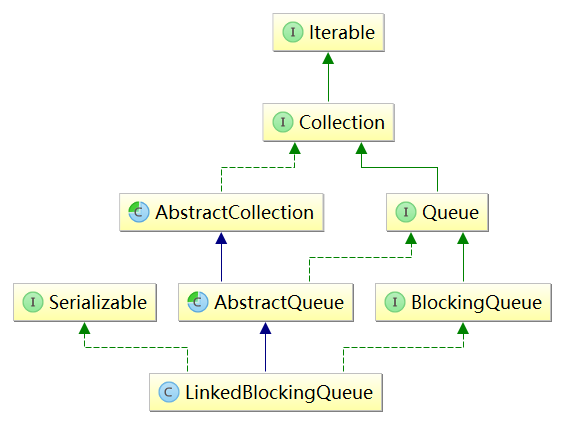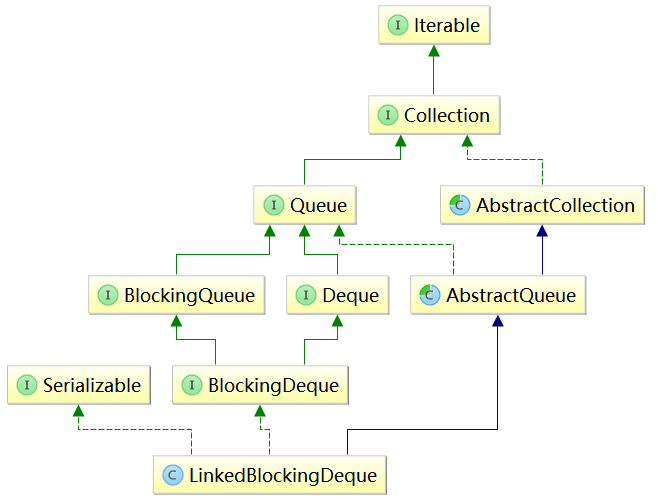//从这可知,LinkedBlockingQueue是个单链表
static class Node<E> {
E item; //数据
Node<E> next; //后继结点
Node(E x) { item = x; }
}2.LinkedBlockingQueue的继承体系
LinkedBlockingQueue的继承关系如下图所示,由继承关系可知LinkedBlockingQueue与ArrayBlockingQueue实现的功能是相同的,只在存储数据结构上不同。其父类及实现的接口在之前的学习中都已分析过,这里不在多说。

3.重要的属性以及构造方法
在LinkedBlockingQueue中保证线程并发安全所使用的的方式与ArrayBlockingQueue相似,都是通过使用重入锁ReentrantLock来实现的,不同的是ArrayBlockingQueue不论出队还是入队使用的都是同一把锁,因此ArrayBlockingQueue在实际使用使是不能出入队并发执行的,而LinkedBlockingQueue在这边方面则不同,LinkedBlockingQueue的出入队是各一把锁,分别控制出入队操作。
public class LinkedBlockingQueue<E> extends AbstractQueue<E>
implements BlockingQueue<E>, java.io.Serializable {
//阻塞队列的容量,不能超过int类型的最大值
private final int capacity;
//队列中元素的数量,是个原子计数类型
private final AtomicInteger count = new AtomicInteger();
//底层链表的头结点,即队首
transient Node<E> head;
//底层链表的尾结点,即队尾
private transient Node<E> last;
//重入锁,用于出队操作
private final ReentrantLock takeLock = new ReentrantLock();
//队列允许出队条件
private final Condition notEmpty = takeLock.newCondition();
//重入锁,用于入地操作
private final ReentrantLock putLock = new ReentrantLock();
//队列允许入队条件
private final Condition notFull = putLock.newCondition();
//默认构造方法,队列容量为最大值
public LinkedBlockingQueue() {
this(Integer.MAX_VALUE);
}
//指定容量的构造方法
public LinkedBlockingQueue(int capacity) {
if (capacity <= 0) throw new IllegalArgumentException();
this.capacity = capacity;
last = head = new Node<E>(null); //初始化链表
}
//拥有初始数据的阻塞队列
public LinkedBlockingQueue(Collection<? extends E> c) {
this(Integer.MAX_VALUE);
final ReentrantLock putLock = this.putLock;
putLock.lock(); // Never contended, but necessary for visibility
try {
int n = 0;
for (E e : c) {
if (e == null)
throw new NullPointerException();
if (n == capacity)
throw new IllegalStateException("Queue full");
enqueue(new Node<E>(e));
++n;
}
count.set(n);
} finally {
putLock.unlock();
}
}
}4.入队过程
与ArrayBlockingQueue相同,LinkedBlockingQueue中的入队方法也是put、add和offer三种,不过相比ArrayBlockingQueue中方法,它们更简单一些。
//父类AbstractQueue中的添加方法,新增失败就抛异常
public boolean add(E e) {
if (offer(e))
return true;
else
throw new IllegalStateException("Queue full");
}
//入队方法,容量不足就放弃入队
public boolean offer(E e) {
//从这可以知道,LinkedBlockingQueue中也是不允许null元素的
if (e == null) throw new NullPointerException();
final AtomicInteger count = this.count; //获取元素计数器
//判断队列是否已满,已满不允许在添加元素到队列中
if (count.get() == capacity)
return false;
int c = -1; //用于记录队列中原有元素的数量
Node<E> node = new Node<E>(e); //新建e元素接地
final ReentrantLock putLock = this.putLock;
putLock.lock(); //入队锁
try {
//获取锁后再次判断队列容量是否已满,已满放弃入队
if (count.get() < capacity) {
enqueue(node); //真正执行入队的方法
c = count.getAndIncrement(); //元素计数+1,并且将原来元素的个数返回
//判断入队后,队列是否还有剩余容量,若有就唤醒其他某个入队操作线程
if (c + 1 < capacity)
notFull.signal();
}
} finally {
putLock.unlock(); //释放锁
}
//判断队列原来是不是空队列,即未新增元素之前是不是为空
//若为空,那么出队操作此时应该都在等待状态,需要唤醒某个出队操作的线程
if (c == 0)
signalNotEmpty(); //唤醒一个出队操作线程
return c >= 0;
}
//向队列中添加队尾元素
private void enqueue(Node<E> node) {
last = last.next = node; //直接添加元素到链表尾结点
}
//唤醒出队操作的线程
private void signalNotEmpty() {
final ReentrantLock takeLock = this.takeLock; //获取出队锁
takeLock.lock();
try {
notEmpty.signal(); //随机唤醒某个出队操作线程
} finally {
takeLock.unlock();
}
}
//在一定时间内执行入队操作,若超过指定时间仍无法入队,那就放弃入队,可被中断
public boolean offer(E e, long timeout, TimeUnit unit)
throws InterruptedException {
//从这可以知道,LinkedBlockingQueue中也是不允许null元素的
if (e == null) throw new NullPointerException();
long nanos = unit.toNanos(timeout); //换算超时时间单位
int c = -1;
final ReentrantLock putLock = this.putLock; //获取入队锁
final AtomicInteger count = this.count; //获取计数器
putLock.lockInterruptibly(); //可被中断的加锁
try {
//判断队列容量是否已满,使用循环是为了防止虚假唤醒
//队列若是已满,则等待一定时间在尝试入队
while (count.get() == capacity) {
if (nanos <= 0) //判断等待时间是否还有剩余
return false; //超时,返回入队失败
nanos = notFull.awaitNanos(nanos);
}
enqueue(new Node<E>(e));
c = count.getAndIncrement();
if (c + 1 < capacity)
notFull.signal();
} finally {
putLock.unlock();
}
if (c == 0)
signalNotEmpty();
return true;
}
//向队列中添加元素,若队列容量不足,则等待直到队列有空间后继续添加
public void put(E e) throws InterruptedException {
if (e == null) throw new NullPointerException();
int c = -1;
Node<E> node = new Node<E>(e);
final ReentrantLock putLock = this.putLock; //获取入队锁
final AtomicInteger count = this.count; //计数器
putLock.lockInterruptibly();
try {
//判断队列是否已满,队列已满则,入队操作线程进入等待状态
//唤醒后要再次判断队列是否有空间,防止虚假唤醒
while (count.get() == capacity) {
//队列已满,线程进入条件队列等待
notFull.await();
}
enqueue(node); //入队
c = count.getAndIncrement(); //获取原数量,并增加队列中的元素数量
if (c + 1 < capacity)
//到此,说明队列中至少有一个元素,那么就能进行出队操作
//因此可以唤醒一个等待出队的线程执行出队操作
notFull.signal();
} finally {
putLock.unlock();
}
/判断队列原来是不是空队列,即未新增元素之前是不是为空
//若为空,那么出队操作此时应该都在等待状态,需要唤醒某个出队操作的线程
if (c == 0)
signalNotEmpty();
}5.出队过程
在LinkedBlockingQueue中的出队方法也是只有两种poll和take,一个不等待,一个等待。
//移除并返回队首元素,若队列为空,则返回null
public E poll() {
final AtomicInteger count = this.count; //获取队列元素个数
if (count.get() == 0) //判断是不是空队列,空队列直接返回null
return null;
E x = null; //用于记录移除出队的结点
int c = -1; //用于记录队列原来结点数量
final ReentrantLock takeLock = this.takeLock;
takeLock.lock();
try {
//判断队列是否为空,不为空才能移除并获取队首结点
if (count.get() > 0) {
x = dequeue();
c = count.getAndDecrement(); //记录旧计数,并结点更新计数
//出队后,队列仍不为空,那么久可以继续唤醒一个出队操作的线程
if (c > 1)
notEmpty.signal();
}
} finally {
takeLock.unlock();
}
if (c == capacity)
signalNotFull();
return x;
}
//在一定时间内尝试出队操作,若超时仍未成功,则返回null
public E poll(long timeout, TimeUnit unit) throws InterruptedException {
E x = null;
int c = -1;
long nanos = unit.toNanos(timeout);
final AtomicInteger count = this.count;
final ReentrantLock takeLock = this.takeLock;
takeLock.lockInterruptibly();
try {
while (count.get() == 0) {
if (nanos <= 0) //判断是否超时
return null;
nanos = notEmpty.awaitNanos(nanos);
}
x = dequeue();
c = count.getAndDecrement();
if (c > 1)
notEmpty.signal();
} finally {
takeLock.unlock();
}
if (c == capacity)
signalNotFull();
return x;
}
//移除并返回队首元素,若队列为空,则等待
public E take() throws InterruptedException {
E x;
int c = -1;
final AtomicInteger count = this.count;
final ReentrantLock takeLock = this.takeLock;
takeLock.lockInterruptibly();
try {
//判断队列是否是空队列,若是空队列那么当前出队操作进入等待状态
while (count.get() == 0) {
notEmpty.await();
}
x = dequeue();
c = count.getAndDecrement();
//判断队列是否为空,队列不空,则可以继续唤醒其他的出队操作线程
if (c > 1)
notEmpty.signal();
} finally {
takeLock.unlock();
}
//判断未进行本次出队操作前队列是否已满,队列若是已满,说明所有的
//入队操作要么处于等待状态,要么不能成功,而现在至少队列执行过一次
//出队操作,此时队列必然还有容量可以执行入队操作,因此可以唤醒任意一个
//执行入队操作的线程
if (c == capacity)
signalNotFull();
return x;
}6.peek方法
//获取但不移除队首元素
public E peek() {
//队列中没有元素的话,就返回null
if (count.get() == 0)
return null;
final ReentrantLock takeLock = this.takeLock;
takeLock.lock();
try {
Node<E> first = head.next; //head.next结点就是队首元素对应的结点
//判断队首是否为null,为null说明队列是空队列
if (first == null)
return null;
else
return first.item;
} finally {
takeLock.unlock();
}
}7.remove方法
//遍历队列查找o元素对应的结点并将其从队列中移除
public boolean remove(Object o) {
if (o == null) return false;
fullyLock(); //获取出入队锁,防止并发问题
try {
//遍历队列对应的链表,查找要移除的元素
for (Node<E> trail = head, p = trail.next;
p != null;
trail = p, p = p.next) {
//判断结点是否是要删除的结点,若是,那就要将该结点从
//链表中移除
if (o.equals(p.item)) {
unlink(p, trail);
return true;
}
}
return false;
} finally {
fullyUnlock(); //将出入队锁都释放
}
}
//删除队列中元素时,要对其他的出入队操作进行同步
//因此删除操作要将出队锁和入队锁都获取到
void fullyLock() {
putLock.lock();
takeLock.lock();
}
//将结点p从链表中移除
void unlink(Node<E> p, Node<E> trail) {
p.item = null;
trail.next = p.next; //trail的后继结点变为p的后继结点
//若是p是尾结点,那么将last变为trail(trail是p的前驱结点)
if (last == p)
last = trail;
//移除一个结点,那么结点计数要-1,并且可以唤醒入队操作的线程了
if (count.getAndDecrement() == capacity)
notFull.signal();
}8.size的统计
public int size() {
return count.get(); //队列中的元素个数直接返回计数器值
}二、LinkedBlockingDueue并发容器
1.LinkedBlockingDueue的底层实现
LinkedBlockingDueue可以看做是LinkedBlockingQueue的升级版,LinkedBlockingQueue能做的LinkedBlockingDueue也能做,不能做的LinkedBlockingDueue还能做,其底层数据结构也是链表,不过与LinkedBlockingQueue的单链表不同,LinkedBlockingDueue是双向链表,并且还可以做堆栈使用。
结点的定义如下:
static final class Node<E> {
//存储数据
E item;
//前驱结点
Node<E> prev;
//后继结点
Node<E> next;
Node(E x) {
item = x;
}
}2.LinkedBlockingDueue的继承关系
LinkedBlockingDueue的继承关系如下所示,相比LinkedBlockingQueue多实现了一个双端队列的接口。

接下来看看BlockingDeque中定义了哪些方法:
public interface BlockingDeque<E> extends BlockingQueue<E>, Deque<E> {
//双端队列中若还有容量,将元素添加到队首,否则抛出异常
void addFirst(E e);
//双端队列中若还有容量,将元素添加到队尾,否则抛出异常
void addLast(E e);
//双端队列中若还有容量,将元素添加到队首,否则返回false
boolean offerFirst(E e);
//双端队列中若还有容量,将元素添加到队尾,否则返回false
boolean offerLast(E e);
//双端队列中若还有容量,立即将元素添加到队首,否则等待容量有空闲在添加
void putFirst(E e) throws InterruptedException;
//双端队列中若还有容量,立即将元素添加到队尾,否则等待容量有空闲在添加
void putLast(E e) throws InterruptedException;
//在一定时间内尝试将元素添加到队首,若到指定时间还没添加成功,则返回false
boolean offerFirst(E e, long timeout, TimeUnit unit)
throws InterruptedException;
//在一定时间内尝试将元素添加到队尾,若到指定时间还没添加成功,则返回false
boolean offerLast(E e, long timeout, TimeUnit unit)
throws InterruptedException;
//若队列不空,立即获取并移除队首元素,若队列已空则等待到队列中有元素在执行
E takeFirst() throws InterruptedException;
//若队列不空,立即获取并移除队尾元素,若队列已空则等待到队列中有元素在执行
E takeLast() throws InterruptedException;
//在一定时间内尝试获取并移除队首元素,若到达指定时间队列中仍没有元素,直接放弃尝试,返回null
E pollFirst(long timeout, TimeUnit unit)
throws InterruptedException;
//在一定时间内尝试获取并移除队尾元素,若到达指定时间队列中仍没有元素,直接放弃尝试,返回null
E pollLast(long timeout, TimeUnit unit)
throws InterruptedException;
//移除队列中第一次出现的o元素
boolean removeFirstOccurrence(Object o);
//移除队列中最后一个出现的o元素
boolean removeLastOccurrence(Object o);
//双端队列中若还有容量,将元素添加到队尾,否则抛出异常
//该方法等同于addLast
boolean add(E e);
//双端队列中若还有容量,将元素添加到队尾,否则返回false
//该方法等同于offerLast
boolean offer(E e);
//若队列不满,则立即向队尾添加元素,否则等待队列有空间后在添加
void put(E e) throws InterruptedException;
//在一定时间内尝试将元素添加到队尾,若到指定时间还没添加成功,则返回false
boolean offer(E e, long timeout, TimeUnit unit)
throws InterruptedException;
//获取并移除队首,若队列为空,则抛异常
E remove();
//获取并移除队首,若队列为空,则返回null
E poll();
//获取并移除队首,若队列为空,则等待队列不为空在执行
E take() throws InterruptedException;
//在一定时间内尝试获取并移除队尾元素,若到达指定时间队列中仍没有元素,直接放弃尝试,返回null
E poll(long timeout, TimeUnit unit)
throws InterruptedException;
//获取但不移除队首元素,若队列为空,那么抛异常
E element();
//获取但不移除队首元素,若队列为空,那么返回null
E peek();
//删除队里中第一次出现的o元素
boolean remove(Object o);
//判断队列中是否含有o元素
public boolean contains(Object o);
//队列中元素的数量
public int size();
//获取队列的迭代器
Iterator<E> iterator();
//向队列中压入一个元素,即向队首添加一个元素,若队列没有
//容量,则抛出异常,等同于addFirst
void push(E e);
}3.重要属性及构造方法
LinkedBlockingDueue也是个容量可选(最大为Integer.MAX_VALUE)的阻塞队列,且线程安全。与LinkedBlockingQueue相似,其线程安全也是通过ReentrantLock来实现的,不过略微不同的似,LinkedBlockingDueue的底层只有一个重入锁,而LinkedBlockingQueue则有两个。
public class LinkedBlockingDeque<E>
extends AbstractQueue<E>
//队列的头结点
transient Node<E> first;
//队尾结点
transient Node<E> last;
//队列中的结点计数
private transient int count;
//队列容量
private final int capacity;
//重入锁
final ReentrantLock lock = new ReentrantLock();
//队列允许出队条件
private final Condition notEmpty = lock.newCondition();
//队列允许入队条件
private final Condition notFull = lock.newCondition();
//使用默认容量的队列
public LinkedBlockingDeque() {
this(Integer.MAX_VALUE);
}
//指定容量的队列
public LinkedBlockingDeque(int capacity) {
if (capacity <= 0) throw new IllegalArgumentException();
this.capacity = capacity;
}
//带有初始元素的队列
public LinkedBlockingDeque(Collection<? extends E> c) {
this(Integer.MAX_VALUE);
final ReentrantLock lock = this.lock;
lock.lock(); // Never contended, but necessary for visibility
try {
for (E e : c) {
if (e == null)
throw new NullPointerException();
if (!linkLast(new Node<E>(e)))
throw new IllegalStateException("Deque full");
}
} finally {
lock.unlock();
}
}
}4.入队过程
由对BlockingDeque的分析可知,LinkedBlockingDueue中存在着大量的入队方法,这里就不一一分析了,因为实现基本都差不多,只挑选个别来看看。
//addFirst方法的本质其实还是调用offerFirst
//向队首新增元素,若队列容量不足,则抛异常
public void addFirst(E e) {
if (!offerFirst(e))
throw new IllegalStateException("Deque full");
}
//向队首新增元素,若队列容量不足,则返回false
public boolean offerFirst(E e) {
//队列中不允许null元素存在
if (e == null) throw new NullPointerException();
Node<E> node = new Node<E>(e); //新建对应结点
final ReentrantLock lock = this.lock;
lock.lock(); //加锁
try {
return linkFirst(node); //真正执行添加队首结点的方法
} finally {
lock.unlock();
}
}
//向队首新增结点
private boolean linkFirst(Node<E> node) {
//判断队列是否已满
if (count >= capacity)
return false; //队列已满直接返回失败
Node<E> f = first; //获取队首结点
node.next = f; //将原队首结点设为新增结点的后继结点
first = node; //将新增结点设为队首结点
//判断原队列中是否为空队列
if (last == null)
last = node; //原队列若为空队列,那么此时队首队尾都是同一个结点
else
f.prev = node; //设置原来的队首结点的前驱结点为新增结点
++count; //队列中的结点数量+1
notEmpty.signal(); //唤醒执行出队操作的线程
return true;
}
//向队尾新增元素,若队列容量不足,则抛异常
public void addLast(E e) {
if (!offerLast(e))
throw new IllegalStateException("Deque full");
}
//向队尾新增元素,若队列容量不足,则返回false
public boolean offerLast(E e) {
if (e == null) throw new NullPointerException();
Node<E> node = new Node<E>(e);
final ReentrantLock lock = this.lock;
lock.lock();
try {
return linkLast(node); //真正实现添加队尾结点的方法
} finally {
lock.unlock();
}
}
//向队尾新增结点
private boolean linkLast(Node<E> node) {
//判断队列是否已满
if (count >= capacity)
return false;
Node<E> l = last; //获取当前队尾结点
node.prev = l; //将新增结点的前驱设为l
last = node; //新增节点设为队尾
//判断队列原本是否为空
//若为空,则新增结点既是队首也是队尾
if (first == null)
first = node;
else
l.next = node; //将l节点的后继设为新增结点
++count; //计数+1
notEmpty.signal(); //唤醒执行出队操作的线程
return true;
}
//向队首新增结点,若队列已满,则等待
public void putFirst(E e) throws InterruptedException {
if (e == null) throw new NullPointerException();
Node<E> node = new Node<E>(e);
final ReentrantLock lock = this.lock;
lock.lock();
try {
while (!linkFirst(node)) //若新增队首结点失败,则线程进入等待状态
notFull.await();
} finally {
lock.unlock();
}
}
//向队尾新增结点,若队列已满,则等待
public void putLast(E e) throws InterruptedException {
if (e == null) throw new NullPointerException();
Node<E> node = new Node<E>(e);
final ReentrantLock lock = this.lock;
lock.lock();
try {
while (!linkLast(node)) //若新增队尾结点失败,则线程进入等待状态
notFull.await();
} finally {
lock.unlock();
}
}5.出队过程
同入队一样,出队的方法也很多,这里也只选个别来分析:
//获取并移除队首元素,若队列为空,则返回null
public E pollFirst() {
final ReentrantLock lock = this.lock;
lock.lock();
try {
return unlinkFirst(); //将队首结点从队列中移除
} finally {
lock.unlock();
}
}
//移除队首节点的方法
private E unlinkFirst() {
//获取队首结点
Node<E> f = first;
//判断队列是否为空队列,空队列直接返回null
if (f == null)
return null;
//获取队首结点的后继结点,要作为新的队首结点
Node<E> n = f.next;
E item = f.item; //获取队首节点的数据,用作返回值
f.item = null; //清空队首结点,方便GC回收
f.next = f; //队首出队的后继设为自己
first = n; //设置新的队首为n
//判断队列是否还有结点
if (n == null)
last = null; //队列若是空了,那么队尾也设为null
else
n.prev = null; //新队首的前驱设为null
--count; //队列中的结点计数-1
//唤醒执行入队操作的线程,队列刚执行一次出队操作,必然有剩余空间
//因此可以执行入队操作
notFull.signal();
return item;
}
//获取并移除队尾元素,若队列为空,则返回null
public E pollLast() {
final ReentrantLock lock = this.lock;
lock.lock();
try {
return unlinkLast(); //将队尾结点从队列中移除
} finally {
lock.unlock();
}
}
//移除队尾结点的方法
private E unlinkLast() {
//获取队尾引用
Node<E> l = last;
//判断队列是否是空队列,空队列直接返回null
if (l == null)
return null;
Node<E> p = l.prev; //获取队尾的前驱结点,用作新的队尾结点
E item = l.item;
l.item = null;
l.prev = l; //队尾结点出队后的前驱设为自身,方便GC回收
last = p; //设置新队尾
//判断队尾出队后队列中是否还是有结点,即队列是否成了空队列
if (p == null)
first = null; //空队列的队首也是null
else
p.next = null; //新队尾的后继设为null
--count; //结点计数-1
notFull.signal(); //唤醒入队操作的线程
return item;
}
//将队首移除并返回,若队列已空则等待
public E takeFirst() throws InterruptedException {
final ReentrantLock lock = this.lock;
lock.lock();
try {
E x;
//判断移除队首结点是否成功,失败则等待
while ( (x = unlinkFirst()) == null)
notEmpty.await();
return x;
} finally {
lock.unlock();
}
}
//将队尾移除并返回,若队列已空则等待
public E takeLast() throws InterruptedException {
final ReentrantLock lock = this.lock;
lock.lock();
try {
E x;
//判断移除队尾结点是否成功,失败则等待
while ( (x = unlinkLast()) == null)
notEmpty.await();
return x;
} finally {
lock.unlock();
}
}6.总结
LinkedBlockingDueue中其他的方法就不一一分析了,都比较简单。
与LinkedBlockingQueue对比,LinkedBlockingDueue的线程安全以及阻塞等待的实现基本没有区别,两个阻塞队列基本可以通用(LinkedBlockingDueue用作栈时除外)。两个队列基本上只有两点不同:一个是底层数据结构的细微区别,LinkedBlockingQueue是单向链表,而LinkedBlockingDueue则是双向链表;另一个是重入锁的使用有些区别,LinkedBlockingDueue不论出入队都使用的是同一个锁对象,而LinkedBlockingQueue的出入队锁是分开的。
来源:oschina
链接:https://my.oschina.net/u/4085994/blog/3044797